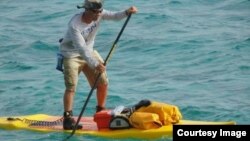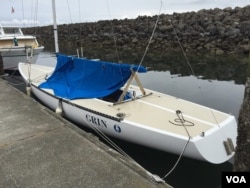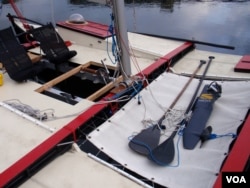For centuries, native canoes have paddled the inside passage to Alaska and next month the historic route will again be teeming with vessels, this time with modern-day sailors out to capture a $10,000 prize.
Organizers say the 1200-kilometer Race to Alaska is the longest human and wind-powered race of its kind and they liken it to the Iditarod on a boat. The route takes mariners from Port Townsend, Washington, up the Inside Passage, to Southeast Alaska.
Jake Beattie's business cards identify him as the "Lead Conspirator" for the Race to Alaska and one of his guiding principles is to keep things simple, with as few rules as possible.
"Get a boat without an engine, any boat, doesn't matter what size or number of crew. Be self-supporting, meaning that you can't have pre-arranged support or boats chasing you around to fix you if you break,” he said. “Start in Port Townsend, finish in Ketchikan. If you're first, we'll give you $10,000. If you're second, we'll give you a set of steak knives."
Everyone else gets a T-shirt.
A dangerous passage
The voyage can be risky, with sailors facing strong tidal currents, whirlpools, floating driftwood and logs that can punch a hole in your hull, bears on shore and sailing in the dark. Professional mariner Jullie Jackson of Port Townsend wouldn’t have it any other way.
"Having a small crew on a boat, you know, you are responsible to those people and they are responsible to you,” she said. “Being able to have a common goal that you are all working toward is really amazing. And it is an absolutely beautiful place in the world."
Jackson and her two crewmates plan to compete in a sleek, racing sailboat called an Etchells 22. It's usually considered a daysailer and offers little protection from the elements.
"I completely understand how people would see it as crazy,” Jackson said. “But if you understand what your limitations are and you understand what risks you are going into, it can be approached in a way that is safe."
Most of the teams entered in the race plan to use sailboats. But if the wind is fickle - as it can be in June - Beattie said the race could go to a small human-powered craft.
"There's one kayaker, a couple of different ocean-going rowboats and one guy on a standup paddleboard who is going to do the entire 750 miles."
Custom-designed craft
At least six teams had a boat custom-designed for this race. That includes world-class sailors Joe Bersch and Dalton Bergan of Seattle. Their brand new 7-meter long outrigger sailboat was inspired by a symmetrical Polynesian design called a proa.
"Both ends of the boat are the bow and the stern," Bergan explained. "It never tacks or jibes, which is what most sailors are familiar with. It just reverses."
Some other unusual features of the sailboat include an auxiliary pedal-powered propeller and a coffin-shaped sleeping compartment the co-captains have already nicknamed the "sarcophagus."
As he worked on the proa, Bersch mused, "There's a tendency to look at some of these boats and say, 'Why are you doing it? You should never try it in that.' Or, 'You'll never win. Why are you doing it?' I think the opportunity to sail up the Inside Passage in a small craft and challenge yourself is a once in a lifetime experience."
If their team - Pure and Wild - takes first place, Bersch and Bergan say they plan to donate their $10,000 grand prize to a charity called SeaShare, which distributes seafood to food banks around the U.S. The team is also trying to raise awareness for Blue H2O, a different nonprofit devoted to increasing access to clean drinking water.
A number of other competitors also are pledging to donate their winnings or are racing for a cause. For example, Victoria, Canada-based Team Blackfish is using the race to raise awareness about British Columbia's Great Bear Rainforest and to promote the conservation group Pacific Wild.
Iditarod 'with a chance of drowning'
Jake Beattie still marvels that his board of directors at the Northwest Maritime Center green lighted the race, which he refers to, with a grin, as 'the Iditarod with a chance of drowning or being eaten by a bear or run over by a freighter.' He sold the board on the idea by pitching the event as an extension on the center's mission to connect people to the sea. He reasoned it would inspire people to adventure and spur conversations about how to get out on the water in low cost ways.
Thirty-five teams from the U.S. and Canada have entered the full race from Port Townsend to Ketchikan. The competition starts with a long open water crossing to Victoria, which will serve as a qualifying leg. Racers who make it to Victoria's Inner Harbor within 36 hours without assistance may continue. The racers will restart at high noon on Sunday, June 7, and head to Ketchikan.
There are two mandatory checkpoints along the way, and all participants are required to carry a satellite tracking beacon and VHF radio for safety. Race officials consulted the U.S. and Canadian Coast Guards about the race safety plan.
Beattie figures the winner of the inaugural Race to Alaska will cross the finish line in less than 14 days, but it could take as little as one week.









